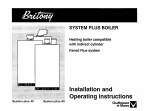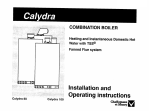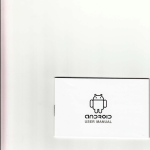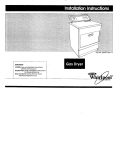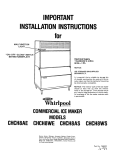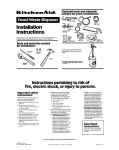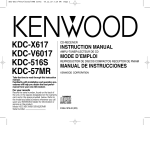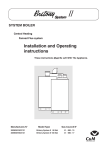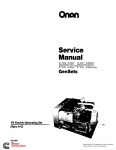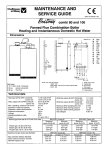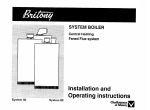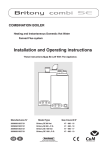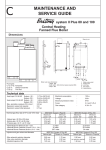Download Chaffoteaux & Maury Britony Combi SE Operating instructions
Transcript
COMBINATION BOILER Heating and Instantaneous Water Domestic Hot Fanned Flue system Combi 80 Combi Installation and -- Operating instructions 100 These instructions are suitable for the following boilers : Britony Combi 80 Britony Combi 100 CUSTOMER CARE Chaffoteaux et Maury Ltd., as a leadrng manufacturer of domestrc and commercral water heatrng applrances, IS committed to provrdrng hrgh qualrty products and a hrgh qualrty after sales servrce If it IS necessary to contact an engrneer, then telephone your local Chaffoteaux Service Centre. The number can be obtarned from the leaflet enclosed rn the customer care pack wrth your boiler or by telephonrng the Chaffoteaux Customer Servrces Department at Telford. Advrce on rnstallatron or servrcrng can also be obtarned by contactrng the Chaffoteaux CUSTOMER SERVICES Tel: 01952 222288 Fax. 01952 260915 Customer Servrces Department at Telford. DEPARTMEN GUARANTEE The manufacturer‘s guarantee IS for 12 months from the date of purchase. The guarantee is voidable d the appliance IS not Installed rn accordance with the recommendatrons made herern or rn a manner not approved by the manufacturer. To assrst us rn provrding you with an effrcrent after sales servrce, please return the guarantee regrstration card enclosed wrth the borler wrthout delay STATUTORY REQUIREMENTS The rnstallatron of thus applrance must be carned out by a CORGI Regrstered Safety (Installatron and Use) Regulatrons. person or other competent person and in accordance with the requrrements of the Gas In addrtron, the rnstallatron must also comply wrth the current byelaws of Local Water Undertakrngs, Burldrng Regulatrons, IEE Winng Regulatrons, Local Authority Burldrng Standards (Scotland) Regulatrons and the Safety Document 635 The Electncrty at work Regulatron. It should also be carned out rn accordance with current edrtrons of the followrng Brrtrsh Standards Codes of practrce: BS 6891, BS 5440 parts 1 and 2, BS 5449 part 1, BS 7593, BS 6798, BS 5546, BS 4814, BS 7074 part 1 and 2, BS 7671 and BG DM2. If there IS a possrbrlity of the Incoming marns water pressure exceedrng 10 bar then a surtable pressure lrmrtrng valve must be frtted To comply wrth the Control of Substances Harmful to Health Regulatron 1988 we are requrred to provrde rnformatron wrthrn the applrance Descrrptron: Combustron Chamber Lrnrng Material: Alumrno SIrcone Fibre on the following substance that IS contarned Precautions. Dunng servrcrng, keep the dust generation to a mrnrmum and avoid Inhaling any dust and contact with the skrn and eyes. Normal handlrng and use wrll not present any drscomfort, although some people wrth a hrstory of skin complarnts may be susceptible to rrntatron. When disposing of the Irmng, ensure that rt IS securely wrapped and wash hands after contact. Page CUSTOMER CARE ............ Guarantee .................... Statutory Requirements ......... Contents ..................... INTRODUCTION .............. DESCRIPTION ................ Location of components ......... TECHNICAL DATA ............. DIMENSIONS ................. OPERATION .................. Domestic Hot Water Mode ....... Central Heating Mode ........... INSTALLATION REQUIREMENTS Location ..................... Flue ......................... Ventilation .................... Gas Supply ................... Electrical Supply ............... SYSTEM GUIDANCE ........... Showers ..................... Flushing and Water Treatment .... System Controls ............... Bypassand pump .............. Expansion Vessel .............. Filling Point ................... 3 3 3 .. .. .. .. .. .. 5 6 6 8 10 12 12 12 14 14 14 15 15 15 16 16 16 16 17 18 18 INSTALLING THE BOILER ..... Installation ................... Fitting the horizontal flue ........ Making the electrical connections COMMISSIONING AND TESTING Pre-commissioning ............ Domestic Hot Water ........... Central Heating ............... Lighting the boiler ............. Post Commissioning ........... Handing over to the Householder ........ USER’S INSTRUCTIONS ............. Control panel ....................... Isolating taps ........................ Switching on ........................ Hot water .......................... Heating and hot water ................. Turn off the boiler .................... INSTRUCTION FOR SETTING THE BUILT IN CLOCK .......................... Mechanical programer ................ Electronic programer ................. 19 19 20 22 24 24 24 24 24 25 25 26 26 26 27 27 27 27 28 28 29 The BRITONY COMBI is a fully automatic, wall mounted, low water content combination boiler. It is a room sealed, fan assisted, balanced flued appliance providing central heating and mains pressure domestic hot water on demand. It has electronic ignition and is suitable for all modern electrical control systems. The boiler is designed for sealed systems only and a circulating pump, expansion vessel together with a pressure gauge and safety valve are included within the boiler. The standard horizontal flue kit is suitable for lengths 300 mm minimum to 610 mm maximum and includes an elbow adapter that can be rotated through 360”. The horizontal flue can extend up to 3 metres using 1 metre flue extension kits. 45” and 90” flue bends are also available as accessories. The BRITONY available. COMBI is also suitable for concentric The boiler is packed in two cartons: 1. the boiler 2. the flue assembly and the pre installation kit vertical flueing and twin pipes. Adapters and accessoiries are Location of components 1. Air pressure switch 2. Steel chassis complete with expansion vessel 3. Main heat exchanger 4. Combustion chamber 5. Multi- gas burner assembly comprising ignition and ionisation electrodes 6. Automatic air separator and automatic vent 7. Heating circuit flow switch 8. Pump 9. Electrical box 10. DHW circuit flow switch 11. Overheat thermostat 12. Gas valve assembly 13. Sealed chamber 14. Flue hood with fan 15. Hot water control thermistor 16. Central heating control thermistor 17. Three way valve 18. CH Flow isolating valve 19. Three position Selector switch 20. User’s instruction panel. 21. Heating flow temperature adjustment 22. Green indicator - Power ON 16 Fig. 3 23. Orange indicator - Burner ON 24. Red indicator - Lock out / fiame failure 25 Reset button 26. Pressure gauge 27.Gas service tap 28. Water service tap 29. CH Return isolating valve 30. Pressure relief valve 21 \ 22 20 31. Secondary heat exchanger 32. By pass 33. By pass adjustment screw i6 Britony combi type Appliance category .......... 80 cat II 2H 3+ 100 cat Britony combi type 80 II 2H 3+ Gas rate Maximum in m3/h Maximum in ft3/h Inlet pressure Nominal in mbar . . Nominal in in wg . . C/H circuit pressures Min operating in bar in lb/in2 Max operating in bar in lb/in* 0.7 10 2.5 36.3 0.7 10 2.5 36.3 DHW flow rates @30”CinI/min ........... in gal/min . @ 35°C in I/min in gal/min 11.1 2.45 9.54 2.10 13.4 2.95 11.48 2.53 DHW circuit pressures Min operating in bar in lb/in2 Max operating in bar in lb/in* Flow limitor rate in Vmin 0.1 1.45 10 145 10 0.1 1.45 10 145 12 100 Natural gas G20 . Burner pressure Nominal in mbar Nominal in in wg . .. Burner injector diamater Natural gas G20 in mm . 2.74 97 3.34 118 20 8 20 8 11 4.4 12.8 5.12 1.23 1.26 PROPANE L.P.G. G31 Gas rate Maximum in kg/h Maximum in ft3/h .. .. 2.00 4.41 2.42 5.34 Inlet pressure Nominal in mbar Nominal in in wg . 37 14.8 37 14.8 35 14 30.4 12.16 Burner pressure Nominal in mbar Nominal in in wg .. Britony combi type 80 100 BUTANE L.P.G. G30 Gas rate Maximum in kg/h Maximum in Lbs/h 2.04 4.50 2.45 5.40 28 11.2 28 11.2 Burner pressure Nominal in mbar Nominal in in wg 26,7 IO,7 24 9.6 Burner injector diamater LPG G30 and G31 in mm 0.72 0.76 Burner injector diamater LPG G30 and G31 in mm 0.72 0.76 Inlet pressure Nominal in mbar Nominal in in wg Compartment ventilation . . . not required Britony combi type Safety discharge in bar . in lb/in*. . . 80 . .. 100 ... . . 3 43.5 3 43.5 Expansion vessel Pre-charge pressure in bar Pre-charge pressure in lb/in* Net capacity at 3 bar in liter 0.7 9.4 5.44 0.7 9.4 5.44 Adjustable by-pass Minimum flow rate Minimum flow rate Maximum flow rate Maximum flow rate 100 0.36 700 2.56 100 0.36 700 2.56 230~ 150w IP 44 2A 1.25A 24v 50 Hz 150w IP44 2A 1.25A 24v Electrical characteristics Supply . Consumption Protection . Fuse+1 . Fusen”2 . External controls in I/h in gal/min in I/h in gal/min . . : Outer case dimensions - W&h : 440 (mnmum - Height : -Depth: Without packaging space required 450) . iii : Tails diameter Safety valve outlet 015mm Heating flow 022mm K D.H.W. flow 015mm L Gas supply 022mm M Cold water inlet 015mm N Heating return 022mm ~1 J Safety valve axe Fig. 4 qI Minimum clearances : - Both sides 5mm - Above casing 170 mm - Below casing 200 mm - Front (for servicing) 500 mm - Front (in operation) 5 mm TYPE Cl2 or C42 Fig. 5 Sizes in mm The boiler is suitable for the 3 flue types : l typeC12 C22orC42 type C 32 xx or C 32 xy l TYPE C32 xx TYPE C32 xy Domestic Hot Water Mode To be able to supply hot water, the selector switch 19 Fig. 6 must be in either on k or ‘1111.? position. This will be confirmed by the green indicator light 0 22 Fig. 6 16 -\ $1 22 26 When a tap or shower is turned on, the flow of mains water, 20 above 2 litres per min., will activate the DHW flow switch 10 Fig. 6 Fig 7 and allow the 3 way valve 17 Fig. 7 to move to the DHW position. The pump can now circulate primary water and ensures accurate temperature regulation heated by the main heat exchanger through the secondary When the tap is closed the burner is extinguished and the pump heat exchanger. stops. The boiler will now stay in the hot water mode for three The first stage solenoid 12a Fig. 7 and safety solenoid 12c minutes to maintain temperature to ensure a fast response in the Fig. 7 open together to allow gas to the burner. The ignition event of a subsequent hot water demand. sequence begins and a continuous high speed spark ignites the gas. As soon as a flame is detected the orange indicator Priority will be given to a demand for hot water. This will interrupt bulb 0 23 Fig. 6 will light and the second stage solenoid 12b the central heating for the duration of hot water delivery. Fig. 7 opens to allow the full gas rate. If a flame is not detected, after 8 seconds, the security solenoid closes and Central Heating Mode shuts off the gas. The red lockout indicator bulb a 24 Fig. 6 will light, The domestic hot water temperature is controlled To be able to supply hot water, the selector switch 19 Fig. 6 by the hot water control thermistor 15 Fig. 7 and the central heating control thermistor 16 Fig. 7. This system anticipates must be in either on .e or ‘Ill1 FF position. This will be the changes of temperature in the secondary heat exchanger confirmed by the green indicator light 0 22 Fig. 6 When there is a demand for heating (either from the room thermostat or the clock) and the boiler temperature control is calling for heat. The pump starts and at a flow rate of 4 Itr/min the central heating flow switch operates allowing the ignition sequence to begin. The first stage solenoid 12a Fig. 7 and safety solenoid 12c Fig. 7 open together to allow gas to the burner. The ignition sequence begins and a continuous high speed spark ignites the gas. As soon as a flame is detected the orange indicator bulb b 23 Fig. 6 will light. After 45 seconds the second stage solenoid 12b Fig. 7 opens to allow the full gas rate. If a flame is not detected, after 8 seconds, the security solenoid closes and shuts off the gas. The red lockout indicator bulb * 24 Fig. 6 will light. The central heating flow temperature is controlled by the central heating control thermistor 16 Fig. 7. The boiler has been designed to minimise cycling and will not attempt to relight for at least 3 minutes after the boiler thermostat has been satisfied. When the room thermostat is satisfied the burner will switch off and the pump will remain running for a further 3 minutes before it to stops. NB It is possible to override the 3 minute delay by pressing the RESET button 25 Fig. 6. Location The boiler can be installed on any suitable internal wall. Provision must be made to allow the correct routing of the flue and siting of the terminal to allow the safe and efficient removal of the flue products. The appliance may be installed in any room, although reference must be made to the IEE regulations if it contains a bath or shower. A compartment or cupboard may be used provided that it has been purpose-built or modified for the purpose. Provision must be made for permanent ventilation. Detailed recommendations are given in BS 5440 pt 2. If it is proposed that it is installed in a timber framed building then reference must be made to British Gas Document DM2, or advice sought from CORGI. Flue The boiler must be installed so that the flue terminal is exposed to the free passage of external air at all times. It must not be allowed to discharge into another room or space such as an outhouse or closed lean-to. The minimum acceptable clearances are shown below: -A -B -C -D -E Directly below an opening, window, etc Below gutters soils pipes or drain pipes Below eaves Below balconies or car port roof From a vertical drain pipe or soil pipe 300 mm 75 mm 200mm 200 mm 75 mm 300 mm - F From an internal or external corner 300 mm - G Above ground roof or balcony level 600 mm - H From a surface facing the terminal 600 mm - I From another terminal facing the terminal -J From an opening into the dwelling when 1200 mm under a car port 1500 mm - K Vertically from a terminal on the same wall - L Horizontally from a terminal on the same wall 300 mm - M fixed by the flat roof ubbink rolux 4GM flue terminal - N fixed by a pithed roof ubbink rolux 4GM flue terminal It may be necessary to protect the terminal with a guard if it is accessible and could be damaged. Reference should be made to the Building Regulations for guidance. Suitable guards may be obtained from the following maufacturer: Quinnel Barret & Quinnel Wireworks Old Kent Road London SE1 5 1 NL Tel: 0171 639 1357 Ventilation The room in which the boiler is installed does not require specific ventilation. IF IT IS INSTALLED IN A CUPBOARD OR COMPARTMENT PERMANENT VENTILATION IS NOT REQUIRED FOR COOLING PURPOSES. If vents are installed, they must communicate with the same room or be on the same wall to outside air. outside air. Gas Supply The gas installation and soundness testing must be in accordance with the requirements of BS 6891.The boiler requires: 2.74 m3/hr and a 22 mm supply. Ensure that the pipe size is adequate for the demand including other gas appliances on the same supply. Electrical Supply The appliance requires an earthed 230V - 50 Hz supply and must be in accordance with current I.E.E. It must also be possible to be able to completely isolate the appliance electrically. Connection should be via a 3 amp fused doublepole isolating switch with contact separation of at least 3 mm on both poles. Alternatively, a fused 3 Amp. 3 pin plug and unswitched socket may be used, provided it is not used in a room containing a bath or shower. It should only supply the appliance. The boiler is suitable for sealed systems only. The maximum working pressure for the appliance is 10 bar. All fittings and pipework connected to the appliance should be of the same standard. If there is a possibility of the incoming mains pressure exceeding 10 bar, particularly at night, then a suitable pressure limiting valve must be fitted. The boiler is designed to provide hot water on demand to multiple outlets within the property. If there is a requirement for greater demands, for example if the property has several bathrooms and cloakrooms, a vented or unvented hot water storage system may be used. guidance. For more information inhibitors, flushing and descaling sought from the manufacturers of such as: Betz Dearbon Foundry Lane Widnes Cheshire WA8 8UD Tel: 0151 424 on the use of corrosion agents, advice can be water treatment products Ltd 5351 Fernox Manufacturing Britannica Works Clavering Essex CBll 4QZ Tel: 01799 550811 Showers Any shower valves used with the appliance should be of a thermostatic or pressure balanced type. Refer to the shower manufacturer for performance guidance and suitability. System Controls Flushing and Water Treatment The performance of the appliance could be impaired by system debris or the effects of corrosion. The system must be flushed thoroughly to remove metal filings, solder, machining oils and other fluxes and greases before connecting the boiler. If it is an existing system, an appropriate flushing and descaling agent should be used. Refer to BS 7593 (1992) for The boiler is electrically controlled and is suitable for most modern electronic time and temperature controls. The addition of such external controls can be beneficial to the efficient operation of the system. The boiler connections for external controls are 24V and so only controls of 24V or that have voltage free contacts should be used. By pass and Pump The boiler is fitted with a pre-adjusted by pass. Although adjustment is not normally necessary, the by pass can be reset by turning screw ( D Fig. 9 ) anticlockwise to open the by-pass using the chart below for guidance. If used on a system with thermostatic radiator valves, the flow rate with the thermostatic valves closed should be adjusted to at least 100 I/hr.The chart below indicates the residual head of the pump available for the system. Head and flow rate available I<- MInImum flow rate m Hz0 D 5 4 3 2 1 0 0 100 200 Fig. 10 300 400 600 600 700 800 90010001100I/h Expansion Filling Point Vessel The expansion vessel is pre-charged to 0.7 bar (10 lb/in*). The vessel is suitable for systems up to 145 litres capacity. For systems of greater capacity an additional expansion vessel will be required. Refer to the chart below and BS 7074 pt 1 or BS 5449. Pressure System capacity ’ 80 Fig. 11 100 120 140 180 180 Provision must be made to be able to charge the system on commissioning and to make up any subsequent pressure loss. The method of connection must utilise approved equipment and must comply with the water regulations. A filling loop can be so installed as to be hidden beneath the boiler. chart 200 220 240 260 Litres Fig. 12 Please check that you are familiar with the installation requirements before commencing work.(section 6) Installation The installation kit included with the flue components comprise following items : - Hanging bracket - A paper template (showing the dimensions of the boiler with 5 mm side clearances, fitting instructions and commissioning instructions) - Connection tails - Screws and wall plugs - Connection washers and filters - Pre-piping jig - Installation manual Drill and plug the wall and secure the hanging bracket using the screws provided. Remove the boiler from its packaging as shown in Fig. 13 and remove the outer case as shown in Fig.1 4. Place the boiler on the wall on the hanging bracket. If required, there is space for all piping to pass behind the Fig. 13 Method of positionning the boiler on the wall. The paper template can be used to ensure the correct positioning of kitchen cabinets etc. It also details the commissioning instructions. The paper template has to be fixed to the wall and used to fix the position of the hanging bracket, the centre for the flue hole and, if required, the fixings for the pre-piping jig. Fig. 14 - boiler. Using Fig. 15 for reference, connect the gas and water pipes to the valves located at the base of the appliance using the tails provided. There is a 190 mm space between the valves and the wall to make these connections. Provision must be made to fill and recharge the system Fig. 15 Safety valve outlet 015mm Heating flow 022mm K D.H.W. flow 015mm L Gas supply 022mm M Cold water inlet 015mm N Heating return 022mm -- pressure. This can be achieved using a filling loop or other methods approved by the local water authority. The pressure relief should terminate below the boiler over a tundish or 22 mm pipe (see I fig 15) which should in turn discharge safely outside the premises. Care should be taken that it does not terminate over an entrance or window or where a discharge of heated water could endanger occupants or passers by. The system should be carefully checked for leaks, as frequent refilling could cause premature system corrosion or unnecessary scaling of the heat exchanger. Fitting the Horizontal Flue The instructions for the vertical and biflux (twin pipe) flue options are included with the relevant adaptor kits. The standard flue supplied with the appliance is suitable for lengths from 300 mm minimum to 610 mm maximum. This means for rear flueing, the standard kit will accommodate a maximum wall thickness of 490 mm, and for side flueing a maximum wall thickness of 477 mm. This takes into account the minimum appliance side clearances of 5 mm. If the fixing is a rear exit flue, the template provides the position of the centre for drilling the flue hole with a core drill. If the flue is a side exit installation then calculate the position of the hole with a slope of 5 mm / metre to the outlet. Connection of the boiler to the system - Hinge down the electrical box to gain access to the valves connections. Push in the tabs (P Fig 19) on either side of the boiler and pivot the box forward. - Remove the yellow caps from connecting pipes and connect the boiler to the taps using gaskets provided in the plastic bag. Washer “R“ for gas connection. Filter “F“ for cold water inlet Fig 16 Making the Electrical Connections Hinge down the electrical box to gain access to the electrical connections. Push in the tabs (P Fig 19) on either side of the boiler and pivot the box forward. Undo the two retaining screws, remove cable clamp. (A Fig 19) remove cover and Connect the live and neutral wires to the multipin plug leaving sufficient earth wire to connect to the earthing point. (B Fig 20) Note: The connections should be made so that should the lead be pulled from its anchorage, the current carrying wires become taut before the earth wire. Fig. 19 Mains THFRMO_TPT connector C Fig. 20 Connect multipin plug onto into the socket on the power board. Secure the cable using the cable clamp and replace the cover. To prevent damage, the cable should then be routed through the cable support on the right hand side of the chassis. Earth pilar B Socket for connector C Fig. 21 If using a room thermostat or other external control, they can be connected in place of the link on the multipin plug. (fig 21) Note: Use only controls designed for voltage free switching or 24V supply. Pre-commissioning Ensure that the system has been adequately flushed. Purge gas supply of air and test for soundness. Carry out final electrical tests to ensure the correct polarity and earthing continuity. DHW Open the main cold feed valve. Open all hot taps to purge DHW system. Check for water soundness. Check flow rate at the bath tap is set at 11 Itr/min for a 30°C temperature rise. Fig. 22 Central Heating Open flow and return valves on the boiler.(l8 and 29 Fig 22) Open the automatic air vent (6 Fig 23) Fill system and vent radiators. Set system pressure and remove filling loop. Check for leaks. Manually check pump is free to turn. Switch on electrical supply. Turn selector switch ( 19 Fig 23) to Winter ( heating and hot water). ‘1111 c? u Allow pump to run for several minutes. Isolate electrical supply. Drain boiler and check water filter for installation debris Replace filter and recharge system. Lighting the Boiler position Connect gas pressure gauge to test point ( 43 Fig. 23). Turn on the gas supply and boiler gas tap ( 27 Fig. 22). Ensure electrical supply is on. Ensure all external controls are calling for heat. boiler operating. (working pressure). Check the operation of the boiler controls and safety devices.(see separate servicing leaflet for details) Re-flush the system to remove any dissolved oils and fluxes. Recharge system pressure and introduce any water treatment as required. Post Commissioning /’ 6 Ensure system pressure has been set correctly. Set boiler thermostat and controls. Set programmer to householder’s requirements. Set external controls. Handing Over to the Householder 21 Fig. 23 Turn selector switch ( 19 Fig. 23) to Winter position ( heating and hot water). ‘Ill1 2 Turn the boiler thermostat to maximum (21 fig 23). The boiler will light. Allow the boiler to heat system. Check that the inlet gas pressure is 20 mbar (8 in wg) with Demonstrate Demonstrate Demonstrate programmer. Explain the person. Explain how the lighting and operation of the boiler. how to maintain the system pressure. the operation and setting of the built-in benefits of annual maintenance by a competent to register guarantee. Leave users instructions, installation documentation with the householder. manual and all other Control panel 25 19. Three position Selector switch l = Switched OFF c ri\ = Hot water only $:\ * ‘1111 = Hot water + Central heating 20. User’s instruction panel. 21. ‘III1 Heating flow temperature adjustment 22. 0 Green indicator - Power ON 23. 4 Orange indicator - Burner ON 24. 4 Red indicator - Lock out / flame failure 25 “RESET’ Reset button 26. @ Pressure gauge Isolating Taps 18. CH Flow isolating valve 27. Gas service tap 28. Water service tap 29. CH Return isolating valve 18 Fig. 25 / 27 I 28 29 Switching on light and the heating will be on. 1) Check that the gas service tap is opened at the gasmeter and main power is on. 2) Check that pressure in central heating system is above 0.7 bar and below 2.5 bar with the pressure gaugea (26). 3) Open the gas tap (27) by turning from right to left. & 4) The boiler is now ready to use. Hot Water 1) Turn selector being delivered. The boiler will switch back automatically to heating when the tap is turned off. Note: If the boiler has been turned off for some time the first attempt to light it may result in a lockout a . If this happens light. switch (19) to position To Turn Boiler “burner h will light and the water will become Heating and Hot Water 1) Turn selector switch (19) to position green “power on” indicator 0 will light. press the reset button (25) and the boiler will ~c . The green “power on” indicator 0 will light. 2) Turn on a hot water tap, the orange indicator When there is a need for hot water while the heating is on, it is only necessary to turn on a hot tap. The heating will be interrupted momentarily while the hot water is hot. me ‘1111.The 3) If the room thermostat (if fitted), the boiler temperature control ‘III1 and the clock (if fitted) are all calling for heat, the orange “burner on ” indicator Off Completely on” 4 will 1) Turn the selector switch (19) to the off position 2) Turn the gas tap (27) from left to right “STOP”. MECHANICAL PROGRAMER r I I I 1. General layout The mechanical clock covers a 24 hour period. Each tappet represents 20 minutes (A Fig. 27). An override switch is located on the right hand side of the clock (B Fig 27). Fig. 26 2. To set the time To set the time of day, grasp the outer edge of the dial and turn slowly clockwise until the correct time is lined up with the arrow. 3. To Set the “On” and “Off” times The clock uses a 24hours system. e.g. 8 =8.00 am and 18 = 6.00 pm “ON” periods are set by sliding all tappets between the “ON” time and the “OFF” time to the outer edge of the dial.The tappets remaining at the centre of the dial are the “OFF” periods. 4. To select function mode Put the selector switch (B) to Automatic to control the boiler by the clock. Put the switch (B) to ON to select permanent operation or to OFF to turn heating off permanently. B Fig. 27 ELECTRONIC PROGRAMER Fig. 28 1. General Layout 2. To Set the “On” and “Off” times In normal use the LCD display shows the day, the time and control status. In other words whether the boiler is on or off, whether it is permanently on or permanently off or whether the override button has been pressed. There is the facility for easy programming. 1. All seven days can be programmed as a block. or 2. Monday to Friday as a block. and then 3. Saturday and Sunday as a block as well as 4. Changing the programme for any individual days. It is advisable to clear the memory before starting. This is done by pressing the reset button for a few seconds with a pencil or similar implement. The screen will show all the symbols. q. chaffoteaux~ e-4A Step 4. Press the H+ (hours) button and the M+ (minutes) button to set the first “on” time of the day. Step 5. Press the v button to select “Switch on“ symbol @ Example 1. The boiler switches week. on at the same time every day of the Step 1. Press Reset button with a pencil or similar tool to clear the memory. Step 2. Press CH button. To select display Step 3. Press DAY button once. Mon to Sun are displayed at the top of the screen. Step 6. Press CH button to store in memory. Step 7. Press day button to display all of the days of the week again. Step 8. Press the H+ and the M+ to set the first “off“ time of the day. Step 9. Press on v button to select “Switch off“ symbol 0 Step 10. Press CH to store. Step 11. Press day, H+, M+ and then CH for each on and off period for a single day.The whole week has now been stored. Step 12. By repeatedly pressing CH each of the times entered can be viewed and checked. At this stage an individual day‘s times can be changed. When that day is displayed, press H+ and M+ as required. Then it is necessary to set the current day and time. Please refer to the relevant section page 32. 12345 1__:__ Example 2 The boiler switches on at the same time Monday to Friday, but at a later time at the weekend. Step 1. Press reset button with a pencil or similar tool to clear the memory and time (only if necessary). The screen will show all the symbols for a few seconds. Step 4. Press the H+ (hours) button and the M+ (minutes) button to set the first “on” time of the day. Step 5. Press Step 6. Press Step 7. Press Step 8. Press the day. Step 2. Press CH button. To select display Step 3. Press day button twice. Mon to Fri is displayed at the top of the screen. on g button to select “Switch on” symbol@ CH button to store in memory. day button twice to display Mon to Fri again. the H+ and the M+ to set the first “off’ time of Step 9. Press on M button to select “Switch off” symbol 0 Step 10. Press CH to store. Step 11. Press day twice, H+, M+ and then CH for each on and off period for a single day.The times for Mon to Fri have now been stored Then it is necessary to set the current day and time. Please refer to the relevant section page 32. 67 1 L-l For the weekend times: Step 1. Press day three times to display Sat and Sun. __:__ 00 D.4Y Hi 0 0 OM+ CH0 . .w . . 1, Reset (hours) and M+ (minutes) buttons to set the current day and time. The Override Button M The override button has four functions. Auto (starting position) The boiler will turn on and off as programmed. Press 8 once for advance /override If boiler is in “off” mode will switch it on. If boiler is in “on” mode will switch boiler Off. Press v again for “FIX ON” [@I Boiler is now permanently on. Press v again for “FIX OFF” COI Boiler is now permanently off. Step 2. As before Press the H+ and the M+ to set the first “on” time of the day. Step 9. Press day three times, H+, M+ and then CH for each on and off period for a single day. The times for the whole weekend have now been stored Step 10. By repeatedly pressing CH each of the times entered can be viewed and checked. At this stage an individual day’s times can be changed. When that day is displayed, press H+ and M+ as required. Note: If only partial information is entered and stored in memory e.g. only hours, or no days are set, then the switching sequence will be ignored. To Set The Current Day And Time Press and hold the 0 button whilst pressing the day, H+ Press v again to go back to Auto. Note : When a manual override is used, the boiler will revert back to the auto setting at the next switching time.When the “Fix On“ or “Fix Off’ position is used, the boiler will only revert back to the auto position by pressing the v One Hour Button button. 21 h This button is used to advance or set back the time by one hour for British Summer / Winter time. There is an indicator on the screen. Chaffoteaux et Maury are continuously improving their products and therefore reserve the right to change specifications without prior notice and accepts no liability for any errors or omission in the information contained in this document. 0 Chaffoteaux et Maury 1996 Chaffoteaux et Maury Ltd Trench Lock Trench Telford Shropshire TFl 4SZ Tel: 01952 222727 Fax: 01952 243493 Cf January 1999 ESP036 ESP036 chaHoteaux~ e-AA




































